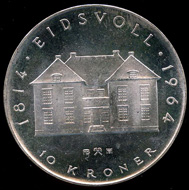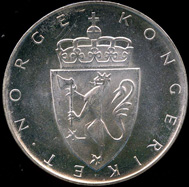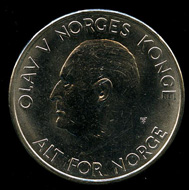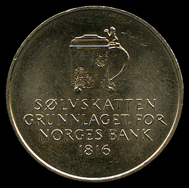by Marius Ringsrud and Nada Kozman
February 7, 2013 – In 2013 the Norwegian 5-kroner coin will celebrate its 50-year anniversary, but perhaps more famously, the 10-kroner nickel silver coin will celebrate 30 years since its introduction in 1983. Since 2006, Norwegian 10-kroner coins have played an important role for many Norwegians, having been used to mark historical institutions and persons using the coins’ creative reverse motifs. The 2013 10-kroner coin will also celebrate 100 years of women’s right to vote in Norway.
10-kroner coin 1964. Photo: www.skanfil.no.
The jubilee of the copper nickel 5-kroner coin, previously called “the manhole cover” because of its large size in the period 1963-1997, lies somewhat in the shadow of the 10-kroner coin’s anniversary.
5-kroner coin 1963. Photo: www.skanfil.no.
However, the 5-kroner coin has been as, if not more, important in marking significant historical events in Norway. Between 1963 and 1997 the coins illustrated King Olav V (1957-1991) and King Harald V (1991-present) on the front side. The reverse side wore the Norwegian national coat of arms. In 1998 the 5-kroner coin’s reverse design was changed to illustrate a beautiful ornamentation which framed a hole in the coin’s centre. In 1998, the design of the front side of the coin was changed to depict the St. Olav’s Order. The St. Olav’s Order is a decoration of very high importance in Norway, and it is only given to a very few people. This design has been current since its first year of issue.
In the period 1975-1997, the 5-kroner coin was used to mark the following key historical events. Special edition coins were struck in 1975, 1978, 1986, 1991, 1995, 1996 and 1997, marking the Coin Convention 100-year jubilee, the first Norwegian emigration to America, the army’s 350-year jubilee, 300 years of coin production at the Royal Mint in Kongsberg, the Central Bank’s 175-year jubilee, 1000 years of coin production in Norway, the United Nation’s 50-year jubilee, the Fram polar expedition and the Norwegian Post Authority’s 350 year jubilee respectively.
5-kroner coin 1991. Photo: www.skanfil.no.
The most interesting 5-kroner piece today might be considered to be the one marking the founding of the Central Bank. This coin from 1991 was the first commemorative piece struck and sold as proper proof coin in Norway. The reverse text “SØLVSKATTEN GRUNNLAGET FOR NORGES BANK 1816” (“silver tax foundation for the Norwegian Central Bank”) pushes the coin holder to remember the establishment of Norway’s Central Bank which included a general extra tax for all inhabitants of Norway. In 2016 the Central Bank will celebrate its 200-year anniversary.
In addition to the upcoming Central Bank jubilee, Norway also faces two other major jubilees in the coming years: both the constitution and the Supreme Court will celebrate 200 years in 2014 and 2015 respectively. According to a press release from 14 November 2012 the Central Bank is planning to strike three so-called §13 Jubilee Coins, that is, normal circulation coins with special motifs designed to celebrate the anniversaries. The celebration of the constitution is the main historic event and the Mint Workers’ Association (Myntarbeidernes fagforbund) has suggested, in a letter from 3 December 2012 to the Constitution Celebration Committee, that the Central Bank should also make jubilee coins according to §16 in the Central Bank law. A §16 jubilee coin is a coin of silver or gold and is not meant to be put in normal circulation. The Mint Workers Association’s wish was further reinforced by a letter from the president of the Norwegian parliament, underlining the importance of the constitution jubilee, and making reference to previous silver Norwegian constitution jubilee coins, marking the 150- and 175-year anniversaries.
You can inform yourself about banknotes and coins on the website of the Norges Bank.









